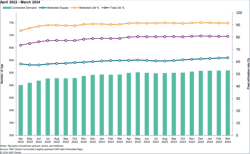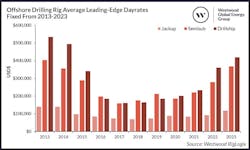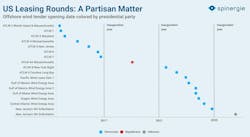Data Briefs
Editor's note: This Data section first appeared in the May-June 2024 issue of Offshore magazine. Click here to view the full issue.
Global rig utilization remains strong and steady
The offshore drilling market has continued to rebound over the last 12 months as contract fixtures in 2022 totaled about 494. The total number of contracted jackups, semis and drillships increased from 542 in March 2023 to 559 through March 2024. At the same time, the global supply of marketed rigs actually grew over that period by 11 units to 610. With that, marketed utilization climbed from 85% in April 2022 to 91% in November 2022 and has remained above the 90% mark ever since. Meanwhile, total utilization has remained steady about 80% ever since April 2023.—Angel Gutierrez, Petrodata by S&P Global
Day rates continue north
The price to rent an offshore rig hit a nine-year high last year with jackups, semisubmersibles and drillships costing on average $118,000, $368,000 and $419,000, respectively (as of Dec. 31, 2023). These figures represent an overall 54% increase in day rates when compared with 2021. This swift rate of cost inflation—sparked by higher global rig demand, rising utilization and tightening availability—has more recently become a factor in the slowdown in contracting activity as operators take stock of their current rig provisions and look at ways to keep future projects economical, as well as being extra careful to make the right rig selection, especially for long-term campaigns.—Westwood Global Energy Group
US offshore wind leasing linked to politics
Do US offshore wind leasing rounds align with political tenures? In short, yes. The Obama administration brought the first push, but the pace slowed during President Trump's tenure. The market has observed a major resurgence under President Biden, however, with ambitious offshore wind capacity targets of 30 GW by 2030 and 15 GW of floating capacity by 2035. Leasing has also expanded into new regions: the Pacific and Gulf of Mexico. These trends underscore the need for political support to deliver on renewable energy implementation. After a challenging 2023, this election year will be crucial for the future of US offshore wind.—Maëlig Gaborieau, Spinergie



